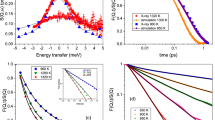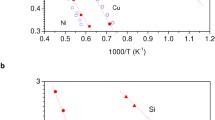Summary
In the present review of liquid dynamics studies on liquid metals are reported. Particularly the case of liquid lead is reviewed because this case was carefully studied by neutron scattering technique,S(Q,ω) being determined at two widely different temperaturesT=623 K andT=1170 K and therefore different densities. In addition extensive supplementary MD simulations were made using a 16 384-particle system. The simulations ranged from a determination of an effective pair potential for lead to simulation of the density correlation functionsF(Q,t) andF s(Q,t), as well as the longitudinal and transversal current correlation functionsJ 1(Q,t) andJ T(Q,t). The MD simulation «calibrated» via the experimentalS(Q) andS(Q,ω) was used to prolong the range of neutron data to draw conclusions regarding such quantities as dispersion relations for the current correlationsJ 1(Q,t) andJ T(Q,t), the generalized viscosity functions ν1(Q,t), ν1(Q) and νs(Q). Information regarding bulk viscosity νB(Q) is also gained. Conclusions are drawn regarding the relative importance of the derived pair potential form by comparison to corresponding hard-sphere data. The general framework of linearized hydrodynamic equations for the macroscopic situation transforming to visco-elastic equations of motion for finite wave-length and high frequency works well also for the case of a continuous potential. The region of transition from simple visco-elastic to hydrodynamic behaviour is occurring at wavelengths in the range (12÷20) Å for the cases studied. The spatial properties of the viscosity functions ν1(r), νs(r) and νB(r) are found to correlate well with the range of the radial distribution function for the liquid. The general results for liquid lead probably have wide range of applicability to other simple liquids with similarS(Q) andg(r) properties.
Riassunto
Nella presente analisi di dinamica dei liquidi si riportano studi sui metalli liquidi. In particolare si riesamina il caso del piombo liquido poiché questo è stato dettagliatamente studiato con la tecnica dello scattering di neutroni, conS(Q,ω) determinato a due temperature molto diverseT=623 K eT=1170 K, e quindi a due densità differenti. Inoltre si sono svolte ampie simulazioni MD supplementari usando un sistema a 16 384 particelle. Le simulazioni sono variate da una determinazione di un potenziale a coppie efficace per il piombo alla simulazione delle funzioni di correlazione di densitàF(Q,t) eF s(Q,t) nonché le funzioni di correlazione di corrente longitudinali e trasversaliJ 1(Q,t) eJ T(Q,t). La simulazione MD «calibrata» viaS(Q) eS(Q,ω) sperimentali è stata usata per prolungare la gamma dei dati neutronici e trarre conclusioni che riguardano quantità come le relazioni di dispersioni per le correlazioni di correnteJ 1(Q,t) eJ T(Q,t) le funzioni di viscosità generalizzate ν1(Q,t), ν1(Q), e νs(Q). Si ottengono anche informazioni che riguardano la viscosità di massa νB(Q). Si traggono conclusioni che riguardano l'importanza relativa della forma del potenziale a coppie dedotta col confronto con i dati corrispondenti della sfera dura. Il quadro generale di equazioni idrodinamiche linearizzate per la situazione macroscopica che si trasformano in equazioni viscoelastiche di moto per lunghezza d'onda finita e alta frequenza si adatta bene anche per il caso di un potenziale continuo. La regione di transizione dal comportamento viscoelastico semplice a quello idrodinamico si verifica a lunghezza d'onda nella gamma (12÷20) Å per i casi studiati. Si trova che le proprietà spaziali delle funzioni di viscosità ν1(r), νs(r), e νB(r) si correlano bene con la gamma della funzione di distribuzione radiale per il liquido. I risultati generali per il piombo liquido hanno probabilmente una gamma ampia di applicabilità ad altri liquidi semplici con proprietà diS(Q) eg(r) simili.
Резюме
Предлагается обзор динамических исследований жидких металлов. Особое внимание уделяется случаю жидкого свинца, так как этот случай был аккуратно исследован с помощью методики рассеяния нейтронов и был определенS(Q,ω) при двух различных температурах и, следовательно, различных плотностяхT=623 K иT=1170 K. Кроме того было проведено MD моделирование, используя систему 16 384 частиц. Моделирование охватывает определение эффективного парного потенциала и приводит к корреляционным функциям плотностиF(Q,t) иF s(Q,t), а также продольной и поперечной корреляционным функциям токаJ 1(Q,t) иJ T(Q,t). MD моделирование, «калиброванное» с помощью экспериментальных данных дляS(Q) иS(Q,ω) было использовано для продолжения области нейтронных данных для получения таких величин, как диспрсионные соотношения для токовых корреляцийJ 1(Q,t) иJ T(Q,t), функций обобщенной вязкости ν1(Q,t), ν1(Q), и νs(Q). Также получается информация об объемной вязкости νB(Q). Делаются выводы, касающиеся относительной важности выведенной формы парного потенциала посредством сравнения с соответствующими эанными для твердых сфер. Общий подход с использованием линерализованных гидродинамических уравнений для макроскопической ситуации, преобразованних к упруговязким уравненияи движения для конечной длины волны и высокой частоты, хорошо работает также в случае непрерывного потенциала. Обнаружено, что пространственные свойства функций вязкости ν1(r), νs(r) и νB(r) хорошо коррелируют с сбластью функции радиального распределения для жидкости. Общие результаты для жидкого свинца, по-видимому, имеют широкую область применимости к другим простым жидкостям с аналогичными свойствамиS(Q) иg(r).
Similar content being viewed by others
References
J. R. D. Copley andJ. M. Rowe:Phys. Rev. A,9, 1656 (1974).
O. Söderström:Phys. Rev. A,23, 785 (1981).
O. Söderström, U. Dahlborg andM. Davidovic:Phys. Rev. A,27, 470 (1983).
O. Söderström, J. R. D. Copley, J. B. Suck andB. Dorner:J. Phys. F,10, L151 (1980).
K. Shibata, S. Hishibo andH. Fujishita:J. Phys. Soc. Jpn.,53, 899 (1984).
U. Dahlborg andL. G. Olsson:Phys. Rev. A,24, 2712 (1982).
J. P. Boon andS. Yip:Molecular Hydrodynamics (McGraw-Hill Int. Book Company, New York, N.Y., 1980), and references therein.
O. Schärpf:Grenoble. Use of polarized neutrons to measure the self-part of the full scattering function (private communication).
U. Dahlborg, W. Gudowski andM. Davidovic:Van Hove correlation functions from coherent inelastic scattering, inJ. Phys. F, in press (1989).
W. E. Alley andB. J. Alder:Phys. Rev. A,27, 3158 (1983).
N. K. Ailawadi, A. Rahman andR. Zwanzig:Phys. Rev. A,4, 1616 (1971).
K.-E. Larsson andW. Gudowski:Phys. Rev. A 33, 1968 (1986).
K.-E. Larsson, W. Gudowski andM. Dzugutov:A liquid metal as an extensive test case of static and dynamic properties Report from a conference onStatic and Dynamic Properties of Liquids, 27 June–1 July 1988 (Dubrovnik, Yugoslavia), edited byM. Davidovic andA. Soper inProc. in Physics (Springer-Verlag, Berlin, 1989).
O. Söderström, U. Dahlborg andW. Gudowski:J. Phys. F,15, L23 (1985).
U. Dahlborg andM. Dzugutov:Collective excitations in a liquid semimetal: molecular dynamics simulation of the dynamics of liquid bismuth (private communication, 1989); paper submitted toPhys. Rev.
M. Dzugutov, K.-E. Larsson andI. Ebbsjö:Phys. Rev. A,38, 3609 (1988).
M. Dzugutov:Pair potential in liquid lead as a test case for the modified hypernetted chain approximation (private communication, 1989, to be published).
J. M. Flin:On the mechanism of volume viscosity in molten lead, molten bismuth and their alloys, Ph. D. dissertation at Catholic University of America (1969).
L. van Hove:Phys. Rev.,95, 249 (1954).
B. N. Brockhouse andN. K. Pope:Phys. Rev. Lett.,3, 259 (1959).
G. Wahnström andL. Sjögren:J. Phys. C,15, 401 (1982)
K.-E. Larsson:Phys. Chem. Liq.,12, 273 (1983) (see particularly p. 322).
K.-E. Larsson:Phys. Chem. Liq.,12, 211 (1983).
W. Gudowski, A. Sjölander andK. E. Larsson: private communication.
See Chapt. V in ref. [7] above.
See Chapt. V and also Chapt. VI, p. 295 in ref. [7].
See Chapt. VI, p. 297 and p. 298 of ref. [7]
R. Stedman, L. Almqvist, G. Nilsson andG. Raunio:Phys. Rev.,162, 545 (1967).
K. S. Singwi:Phys. Rev. A,136 969 (1964);K. S. Singwi:Physica,31, 1257 (1965).
K.-E. Larsson, U. Dahlborg andD. Jovic: inInelastic Scattering of Neutrons, Vol. 2, p. 117, inProceedings of a Symposium in Bombay, 15–19 Dec. 1964, published by International Atomic Energy Agency (Vienna, 1965).
U. Dahlborg andK.-E. Larsson:Ark. Fys.,33, 271 (1966).
K. S. Singwi andG. Feldman: inInelastic Scattering of Neutrons, Vol.2, p. 117, inProceedings of a Symposium in Bombay, 15–19 Dec. 1964 (International Atomic Energy Agency, Vienna, 1965).
K.-E. Larsson:Phys. Chem. Liq.,9, 117 (1980).
G. H. Vineyard:Phys. Rev.,110, 999 (1958).
Author information
Authors and Affiliations
Additional information
The authors have agreed not to receive proofs for correction.
Rights and permissions
About this article
Cite this article
Larsson, K.E., Dzugutov, M. & Gudowski, W. From macroscopic to atomic motions in liquid metals. Il Nuovo Cimento D 12, 559–586 (1990). https://doi.org/10.1007/BF02453311
Received:
Issue Date:
DOI: https://doi.org/10.1007/BF02453311




